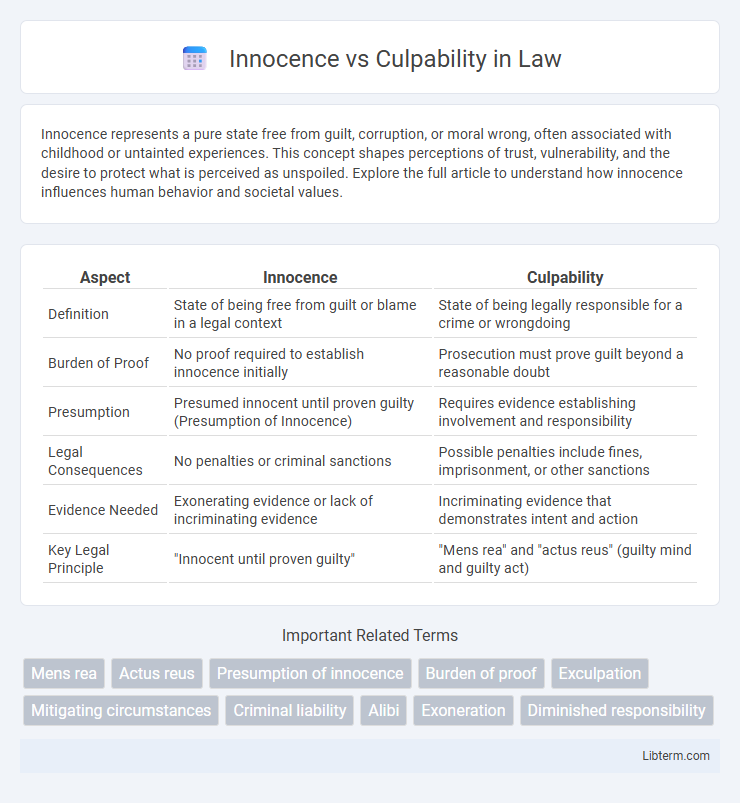Innocence represents a pure state free from guilt, corruption, or moral wrong, often associated with childhood or untainted experiences. This concept shapes perceptions of trust, vulnerability, and the desire to protect what is perceived as unspoiled. Explore the full article to understand how innocence influences human behavior and societal values.
Table of Comparison
| Aspect | Innocence | Culpability |
|---|---|---|
| Definition | State of being free from guilt or blame in a legal context | State of being legally responsible for a crime or wrongdoing |
| Burden of Proof | No proof required to establish innocence initially | Prosecution must prove guilt beyond a reasonable doubt |
| Presumption | Presumed innocent until proven guilty (Presumption of Innocence) | Requires evidence establishing involvement and responsibility |
| Legal Consequences | No penalties or criminal sanctions | Possible penalties include fines, imprisonment, or other sanctions |
| Evidence Needed | Exonerating evidence or lack of incriminating evidence | Incriminating evidence that demonstrates intent and action |
| Key Legal Principle | "Innocent until proven guilty" | "Mens rea" and "actus reus" (guilty mind and guilty act) |
Defining Innocence and Culpability
Innocence is defined as the absence of guilt or wrongdoing, signifying a state where an individual has not committed a crime or offense under legal or moral standards. Culpability refers to the degree of responsibility or blame assigned to a person for an act deemed wrongful or criminal, often evaluated through intent, negligence, or recklessness. Legal systems utilize evidence and intent assessments to differentiate innocence from culpability, determining accountability in judicial proceedings.
Historical Perspectives on Justice
Historical perspectives on justice reveal evolving interpretations of innocence versus culpability, influenced by cultural, legal, and philosophical paradigms. Ancient legal systems, such as Hammurabi's Code, emphasized strict retribution with limited distinction between innocence and guilt, whereas Enlightenment thinkers like Cesare Beccaria championed proportional punishment and the presumption of innocence. The development of modern jurisprudence reflects a shift toward safeguarding individual rights and ensuring fair trials to accurately ascertain culpability while protecting presumed innocence.
Societal Constructs of Guilt
Societal constructs of guilt shape perceptions of innocence and culpability by establishing norms that define acceptable behavior and moral responsibility. Legal systems and cultural narratives often intertwine, influencing how communities assign blame and forgiveness. These constructs impact the outcomes of justice processes, affecting rehabilitation and social reintegration.
Psychological Foundations of Innocence
The psychological foundations of innocence are rooted in cognitive development stages where moral reasoning and the understanding of right and wrong are still forming, often observed in children whose actions lack intentional harm. Neuroscientific studies highlight the role of the prefrontal cortex in impulse control and decision-making, which is less developed in individuals deemed innocent or lacking culpability. Furthermore, empathy deficits and impaired moral cognition, linked to abnormalities in the amygdala and mirror neuron systems, contribute to the differentiation between innocence and culpability in psychological assessments.
Legal Interpretations and Implications
Legal interpretations of innocence versus culpability hinge on the burden of proof, requiring the prosecution to establish guilt beyond a reasonable doubt while the defendant is presumed innocent. Courts analyze evidence through standards such as mens rea (criminal intent) and actus reus (criminal act) to differentiate between innocence and culpability. Implications of these interpretations affect sentencing, rehabilitation opportunities, and the protection of individual rights within the judicial system.
The Role of Evidence in Determining Blame
The role of evidence is critical in distinguishing innocence from culpability, as it provides objective facts that establish the presence or absence of guilt. Forensic data, witness testimonies, and digital footprints serve as crucial tools in constructing a reliable narrative that supports or refutes accusations. Proper analysis and interpretation of this evidence ensure fair judgments and uphold justice by clearly allocating blame based on verified information.
Innocence in Media Representation
In media representation, innocence is often portrayed as a symbolic state of purity and moral virtue, emphasizing vulnerability and the absence of guilt. Visual and narrative cues like childlike behavior, white clothing, and sanctified imagery reinforce this portrayal to evoke empathy and protectiveness among audiences. Such depictions serve to influence public perception by framing characters or individuals within a moral dichotomy that highlights their perceived blamelessness in contrast to those deemed culpable.
Moral Ambiguity and Ethical Dilemmas
Moral ambiguity in the conflict between innocence and culpability arises when actions blur the lines between right and wrong, challenging clear judgments of guilt. Ethical dilemmas emerge as individuals navigate conflicting values, often questioning whether intent or outcome should determine accountability. This nuanced interplay complicates justice by emphasizing context, motivation, and the complexity of human behavior over simplistic categorizations.
Consequences of Wrongful Accusations
Wrongful accusations of innocence can lead to severe consequences such as loss of reputation, emotional trauma, and psychological distress for the falsely accused individuals. In the criminal justice system, these errors undermine public trust, result in miscarriages of justice, and divert resources away from identifying actual perpetrators. Compensation claims and reform efforts highlight the need for improved investigative accuracy and fair due process to prevent the damaging effects of misjudged culpability.
Navigating the Gray Area Between Innocence and Guilt
Navigating the gray area between innocence and guilt challenges legal systems to balance evidence interpretation with moral judgment, emphasizing the importance of thorough investigations and fair trials. Understanding the nuances of human behavior and circumstantial evidence is crucial for distinguishing culpability from reasonable doubt. Advances in forensic science and legal psychology continuously reshape how innocence and guilt are assessed in complex cases.
Innocence Infographic

 libterm.com
libterm.com